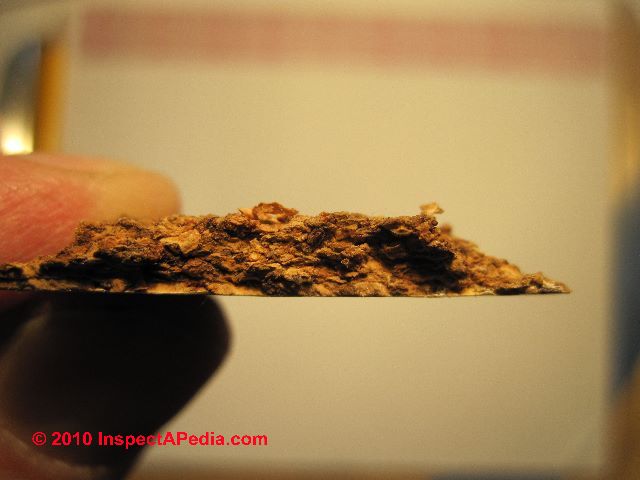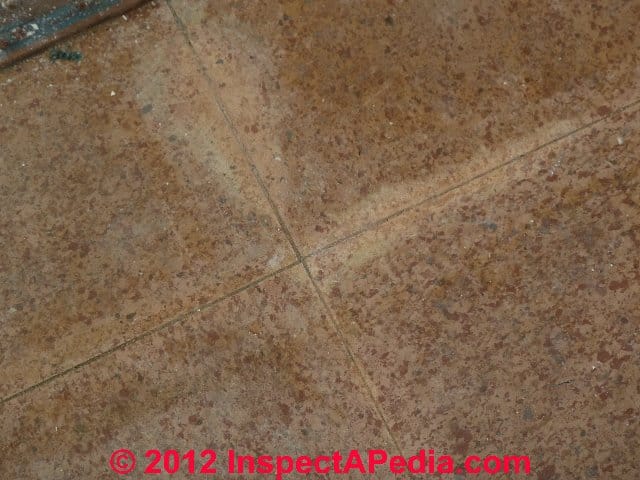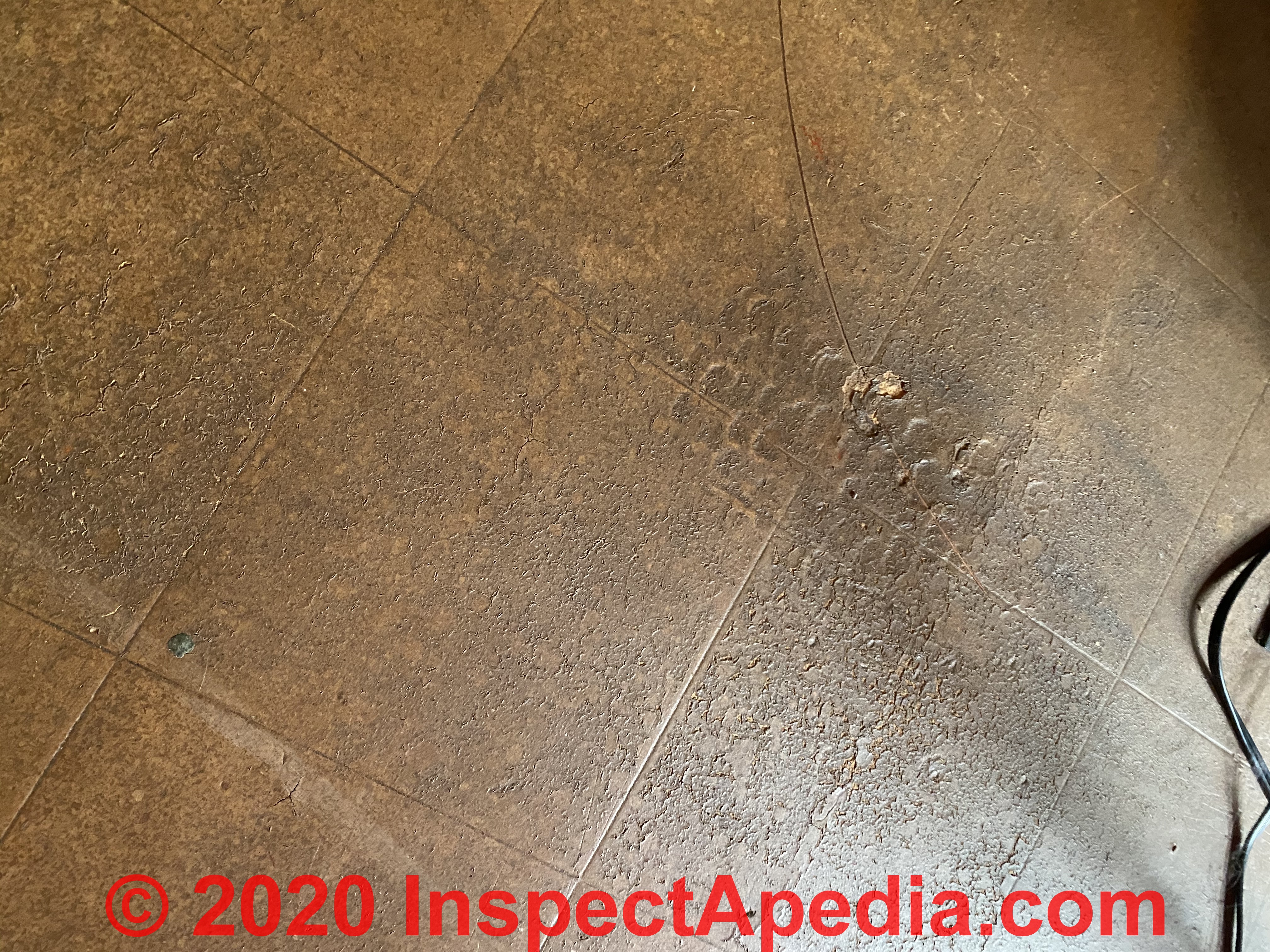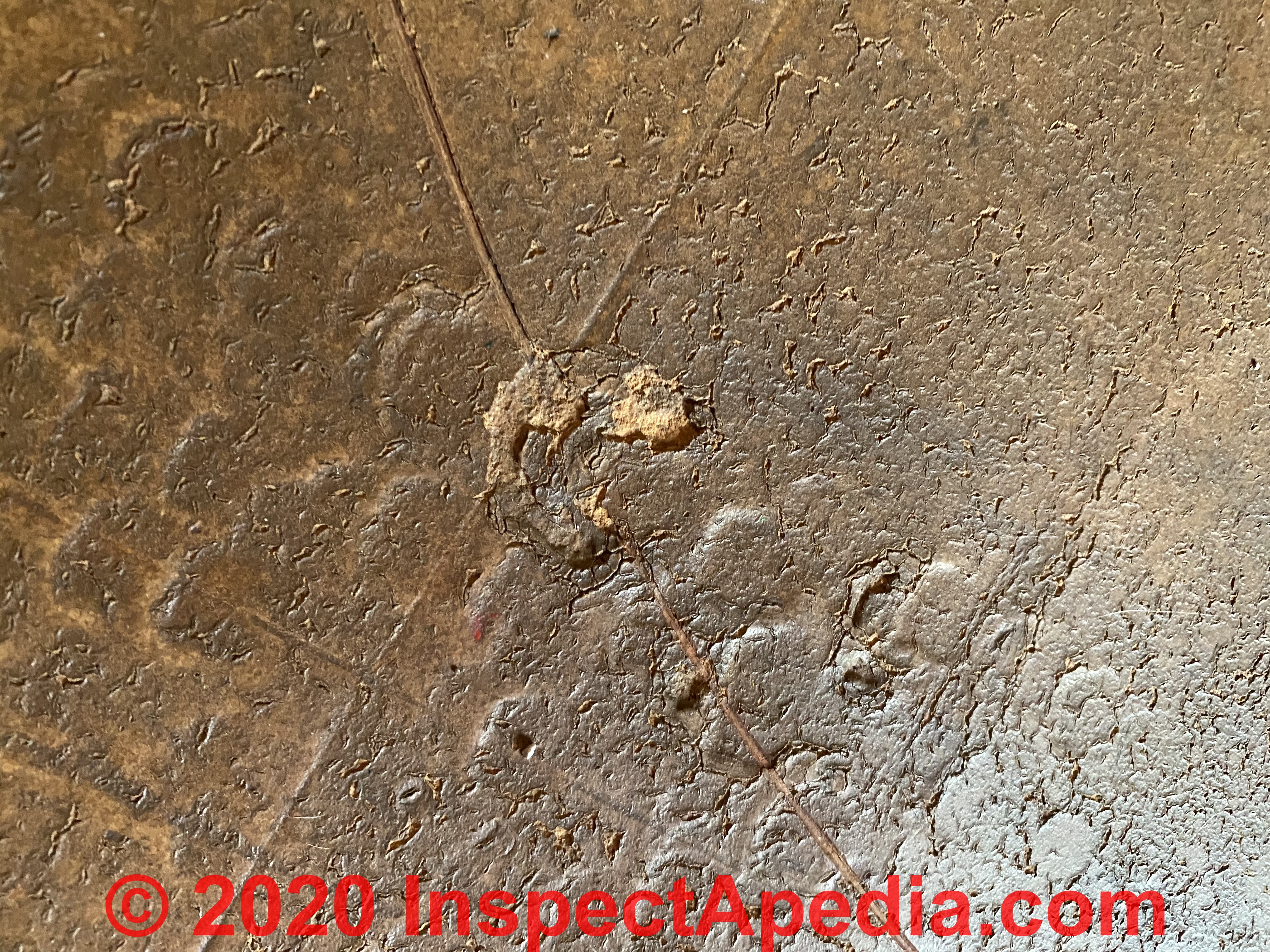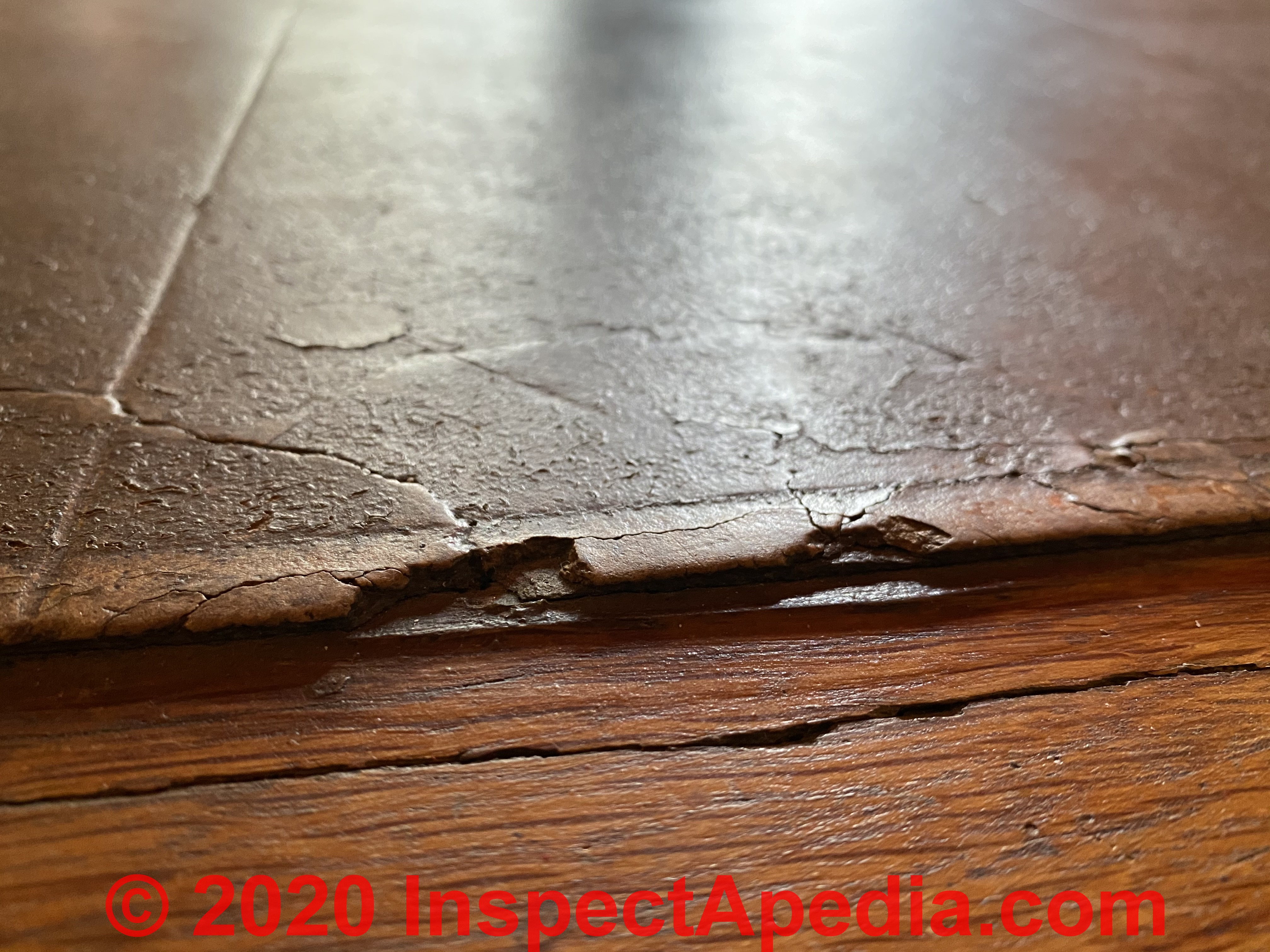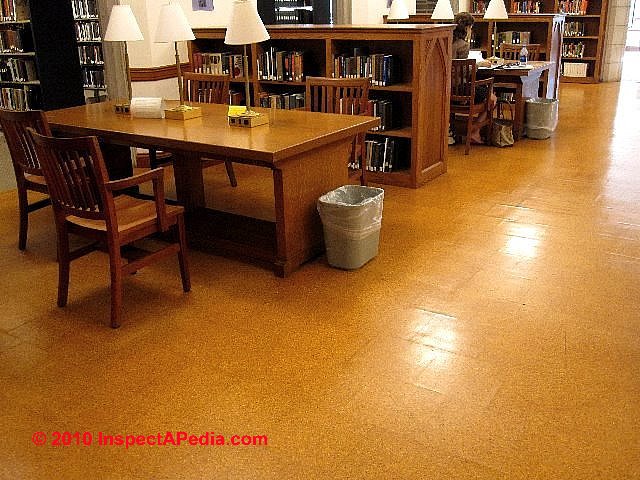 Cork Flooring Identification, History, Products
Cork Flooring Identification, History, Products
Resilient floor coverings using cork tiles or sheets
- POST a QUESTION or COMMENT about how to buy, inspect, troubleshoot, repair resilient flooring
Guide to historic & modern cork floors & cork resilient flooring. This article describes the properties of cork floor tiles & cork sheets installed to provide a quiet resilient floor covering. We give sources for current cork floor covering products.
This article series discusses and provides a best construction practices guide to the selection and installation of building interior surface materials, carpeting, doors, drywall, trim, flooring, lighting, plaster, materials, finishes, and sound control materials.
This article includes excerpts or adaptations from Best Practices Guide to Residential Construction, by Steven Bliss, courtesy of Wiley & Sons.
Our flooring photos and explanation of how we distinguish cork flooring from asphalt-asbestos or vinyl-asbestos flooring are by Daniel Friedman, website editor, environmental and building inspector and forensic lab technician since 1978.
Our page top photo shows a cork tile floor installed in the Vassar College Library, Poughkeepsie, NY.
InspectAPedia tolerates no conflicts of interest. We have no relationship with advertisers, products, or services discussed at this website.
- Daniel Friedman, Publisher/Editor/Author - See WHO ARE WE?
Cork Floors - a Resilient Floor Natural Alternative to Vinyl
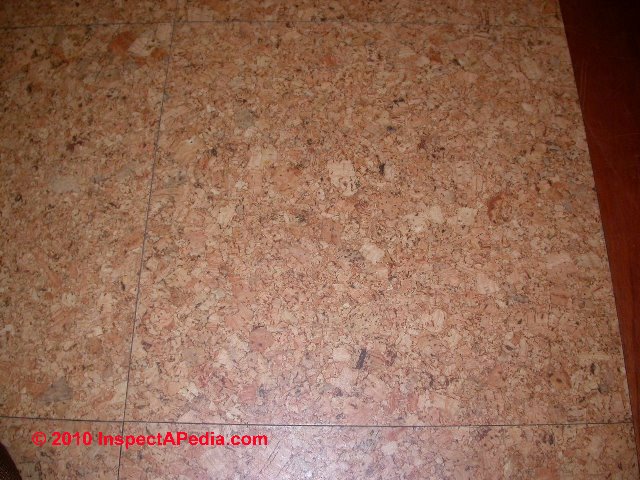 Homeowners who want a resilient floor covering but are
looking for an alternative to vinyl should consider the new
cork products as well as traditional linoleum, which is
enjoying a comeback in residential applications.
Homeowners who want a resilient floor covering but are
looking for an alternative to vinyl should consider the new
cork products as well as traditional linoleum, which is
enjoying a comeback in residential applications.
Cork Floor Properties, Selection & Installation Procedures
Cork is a renewable resource that is harvested every 9 or 10 years from the outer bark layer of cork oak trees in Portugal and other Mediterranean countries.
Cork has a number of desirable attributes for a flooring material: its air-filled, watertight cells are strong, soft to walk on, and insulating, making it a good choice over a concrete slab.
To make it into flooring, manufacturers grind up the cork, mix it with a chemical binder, bake the material, and slice it into sheets. Cork flooring products range in thickness from 3/16 to 7/16- inch for some laminated products.
Most cork flooring is sold as tiles and installed with adhesive, similarly to other resilient tiles.
Cork tiles are available either unfinished or prefinished with carnauba wax or a more durable polyurethane or acrylic coating.
Cork floor tiles tend to have natural color variation and can be purchased in light, medium, or dark tones.
As with wood floors, wax finishes need regular buffing and periodic re waxing, depending on use. Polyurethane-finished cork typically needs re coating in four to eight years.
One advantage of purchasing unfinished tiles and finishing in place is better protection against moisture penetration between tiles. The cork itself is moderately water-resistant.
A variety of other cork and cork composite products are now on the market, including tongue-and-groove (T&G) floating floors and cork and vinyl laminates.
A number of manufacturers now offer 12x36-inch floating T&G planks with an MDF core sandwiched between a cork underlayment and aggregate cork wear layer.
Cork Floor Tiles or Cork Planks
Cork floors, real cork flooring, were and are a wood product made out of cork from the cork oak tree (Quercus suber) native to Mediterranean countries, primarily Spain and Portugal. The bark of the cork oak is or was harvested once every nine or ten years, without injuring the tree. The epitome of a resilient floor, cork flooring can compress up to 40% and still return to its original shape.
Early cork flooring product names found in North America included Kencork™, Linotile™, and Corkoustic™, and modern cork floor products continue to be widely available, as we describe below.
Cork flooring is a resilient relative of linoleum made with cork chips. The chips, ground less finely than the cork used in linoleum, were pressed into molds and baked.
This process melted the cork’s natural resins and created a homogenous material. After World War II, manufacturers commonly added resins to strengthen cork tiles. - Wilson & Snodgrass, U.S. FPL (2007)
Armstrong Cork Floor Tiles
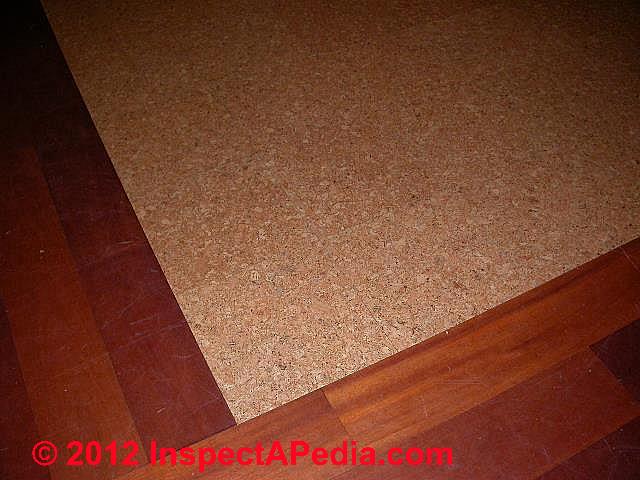 In the U.S. Thomas Armstrong, a Scotch-Irish immigrant, began his business as a cork cutter in 1860, delivering hand-carved bottle corks by wheelbarrow. The use of cork expanded to the construction of corkboards (bulletin boards) and cork-insulated brick.
In the U.S. Thomas Armstrong, a Scotch-Irish immigrant, began his business as a cork cutter in 1860, delivering hand-carved bottle corks by wheelbarrow. The use of cork expanded to the construction of corkboards (bulletin boards) and cork-insulated brick.
By 1909 Armstrong had begun producing linoleum. "Corkboard led to fiberboard, fiberboard led to ceiling board, cork floor tile led to linoleum that ultimately led to vinyl floor coverings, in both tile and sheet vinyl forms.
Armstrong's familiarity with cork grew into today's Armstrong Corporation worldwide as one of the largest flooring producers.
See ARMSTRONG FLOORING HISTORY
Dodge Cork Floor Tiles
The Dodge Cork Company, a second Lancaster PA flooring company, also has a long history in floor covering production, dating from its founding in 1926.
Dodge Cork notes that their cork floors were used by Frank Lloyd Wright at Falling Waters and of course in many other buildings and that the company was producing a million square feet of cork floor tiles a month by 1962, probably a peak in the cork floor market.
As our photograph above indicates (Vassar College, Poughkeepsie, NY new cork flooring), cork flooring installations from various manufacturers continue to be placed today.
But as the company indicates at their website, "Dodge Cork Products are manufactured in Portugal in accordance with USA specifications and regulations."
Cork floor tiles were considered a warm, quiet, but less durable (by some sources) resilient floor covering than some of its harder-surfaced competitors.
Actually some early cork floors installed in the U.S. (the 1930's U.S. Department of Commerce building) are still in use today, arguing for its durability.
Cork flooring was sold in both tiles and cork planks, often for use in residential dens, family rooms, or other warm, low-traffic areas, and it may have been popular (research needed) for use in areas where workers had to spend long periods standing - where it would have competed with rubber floor coverings.
Led by flooring producer Armstrong, cork flooring was popular in the U.S. particularly from 1900 to 1945. By 1952 cork flooring sales made up just 2% of total floor tile sales. -- Rosato p88.
Don't mistake actual cork floor tiles for vinyl-asbestos cork pattern flooring.
See ASBESTOS FLOOR TILE PHOTO ID GUIDE - detailed photo guide to asphalt asbestos and vinyl asbestos floor tiles, 1900 -1986
Our lab photos above and below, show close ups of fragments of cork flooring found in a 1949 home (the flooring may be newer) contributed by reader R.D., Tonawanda, NY.
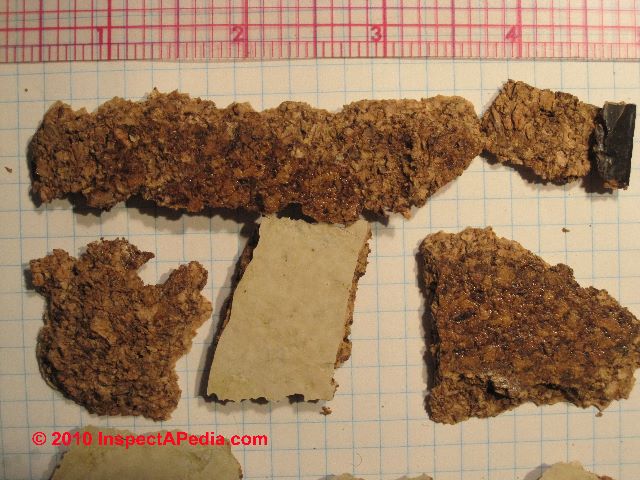
Watch out: vinyl-asbestos flooring was produced by several manufacturers in patterns that closely resemble actual real cork.
See ASBESTOS FLOOR TILE PHOTO ID GUIDE for examples. Examination of a flooring sample in cross-section (above) shows the use of cork materials throughout the 5mm (3/16") thickness of this sample that was painted or coated on its upper surface with a light white/beige coating.
Where to Buy Cork Floor Tiles or Cork Floor Coverings
Manufacturers producing modern cork flooring in tile or sheet forms include Korq, Inc., American Cork Products Company, and Nova Distinctive Floors, which offers a unique no-glue option.
Some manufacturers offer a composite product with an inner layer of cork sandwiched between a thick vinyl wear layer and vinyl backing.
See BUY INTERIOR FINISH PRODUCTS
While cork products appeal to healthy-house advocates, the binders and adhesives used with tiles, and the fiberboard or vinyl layers used in laminated products, may not provide the completely nontoxic, non-offgassing material desired. Using solid-cork (aggregate) tiles with a low-VOC adhesive is probably the best choice for those seeking natural, nontoxic materials.
Cork Flooring Manufacturers & Sources
- American Cork Products Co. www.amcork.com Prefinished parquet tiles and floating floor planks
- Amorim Revestimentos (formerly Ipocork) www.wicanders.com Floating or glue-down laminated cork tiles with UV-acrylic or oil finish
- BHK of America www.bhkuniclic.com Snap-together, no-glue, laminated cork flooring with UV-acrylic finish
- Expanko Cork Inc. www.expanko.com Cork tiles with wax or polyurethane finish
- Korq Inc. (212) 758-2593
- Natural Cork www.naturalcork.com Glue-down cork tiles and floating laminated planks with UV-cured acrylic finish
- Nova Distinctive Floors www.novafloorings.com Laminated cork planks with glue-down and floating click-lock installation
- WECork www.wecork.com Cork tiles, sheets, and floating floors
Does Cork Flooring Contain Asbestos?
Can you identify these cork pattern floor tiles as probably containing asbestos?
An InspectApedia reader wrote to us and included photos of cork pattern floor tiles in his home, asking if these were cork or something else.
Below we show how we can easily distinguish true cork flooring from asphalt-asbestos or vinyl-asbestos cork-pattern floor tiles, simply by visual examination.
Keep in mind that not all floor tiles contain asbestos; to know if a floor tile product contains asbestos, you'll start by finding out or estimating when and where your flooring was manufactured.
Great website you have, it's been a good resource for me.
I suspect that these are asbestos tiles. Any idea? - G.M. 1/1/2013
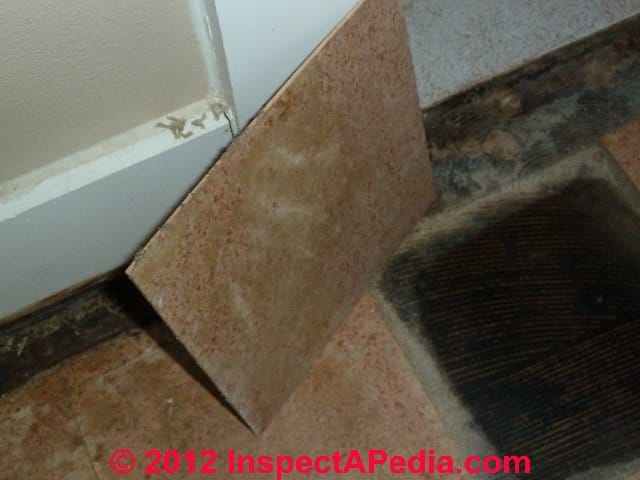
How to Easily Distinguish Asphalt-Asbestos or Vinyl Asbestos Floor Tiles from True Cork Flooring
The reader's photos (above) look to me (DF) like a 1970s vinyl-asbestos floor tiles in the cork pattern. These are not true "cork".
The edge of this reader's floor tile is solid, homogeneous, and thin as you can see in our excerpt from his photo (below).
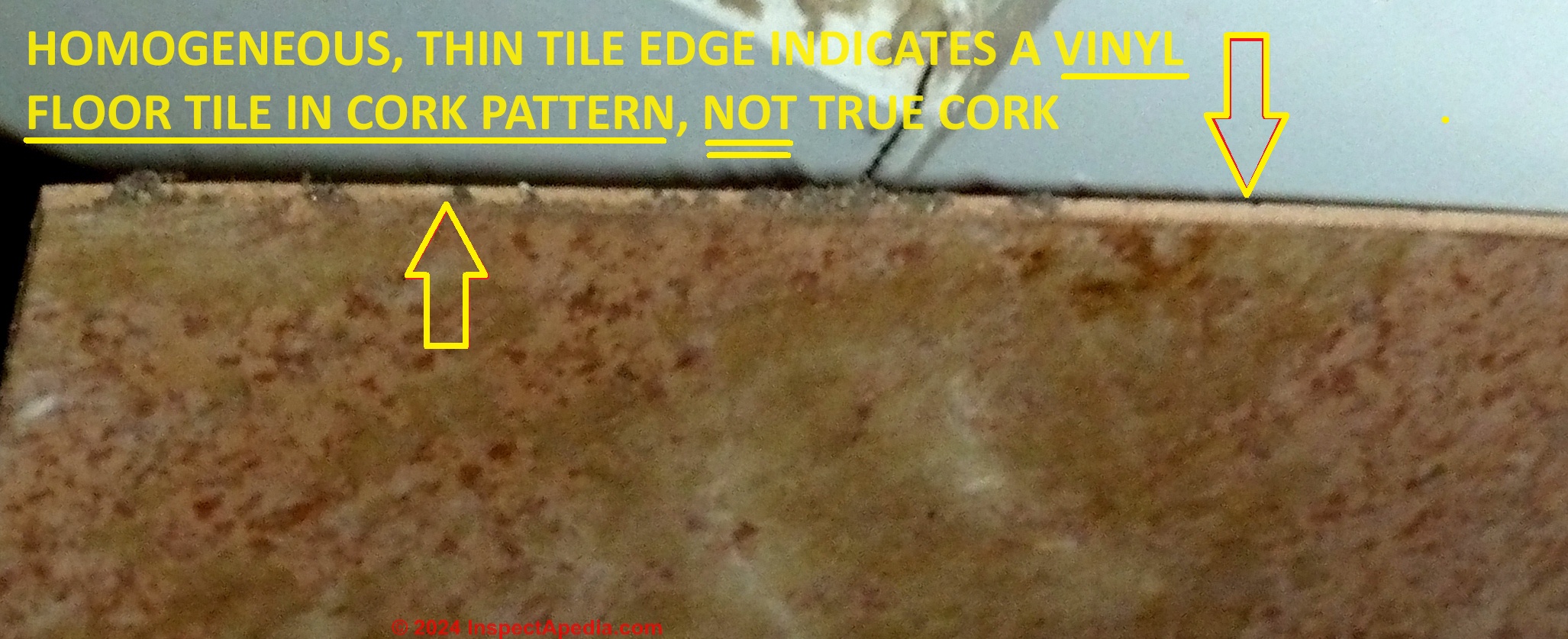
Below, for reference we show additional edge views of asphalt asbestos and vinyl-asbestos floor tiles from samples in our forensic laboratory, under the stereo microscope, held in edge-view with a millimeter ruler for scale.
First we show a relatively thick 3.6mm green asphalt-asbestos floor tile from a sample we collected from the bathroom floor in a 1930's farmhouse in Rhinebeck New York.
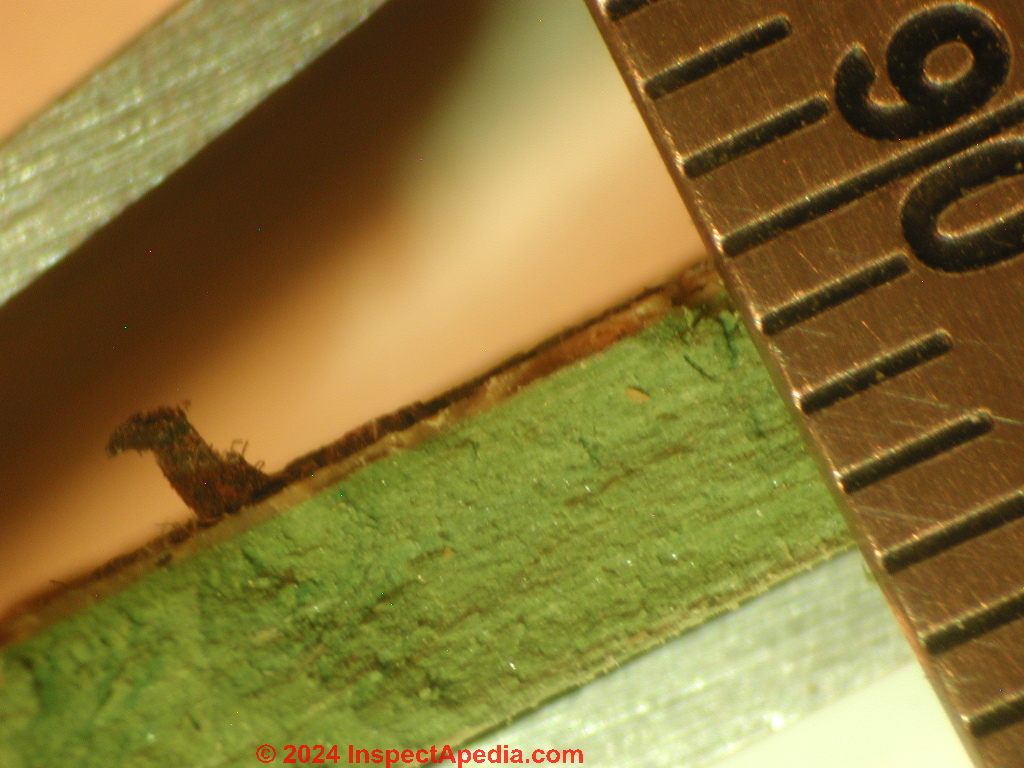
Next (below) we show a somewhat thinner edge view of a somewhat less robust 2mm thick red asphalt-asbestos floor tile from a 1955 home in Wappingers Falls, New York.
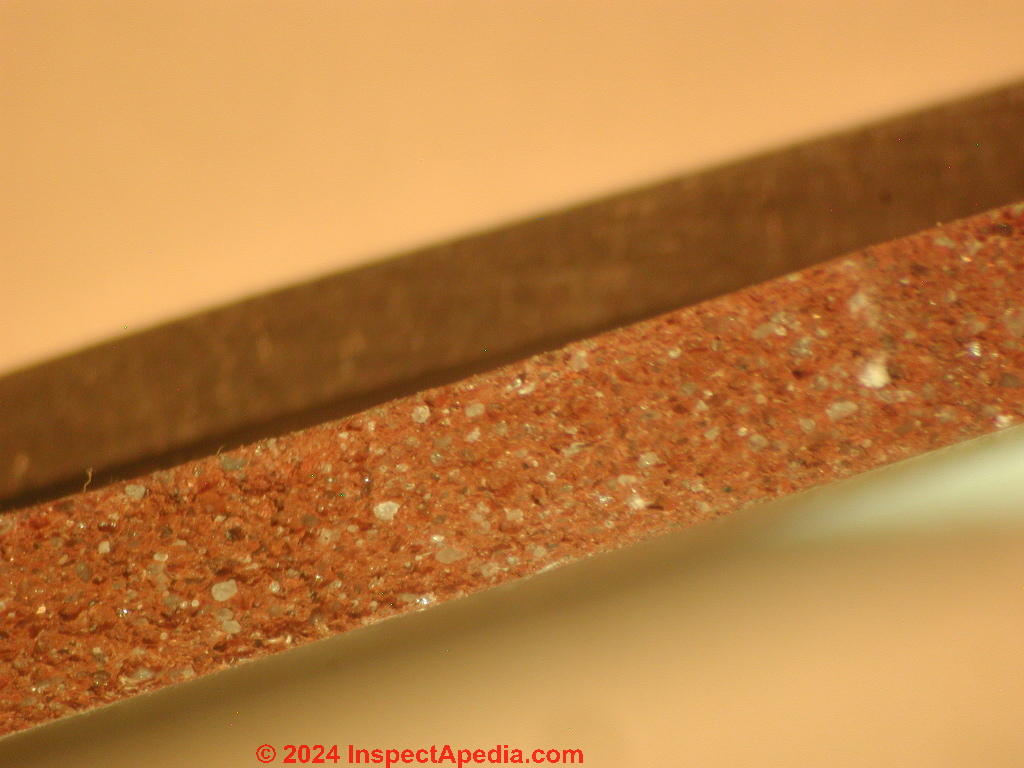
And third (below) we show a much thinner vinyl-asbestos floor tile produced by Montgomery Wards and collected from a home along Wappingers Creek in Poughkeepsie, New York. The home was built in 1929 but we think this floor was probably installed in the 1960s or 1970s.
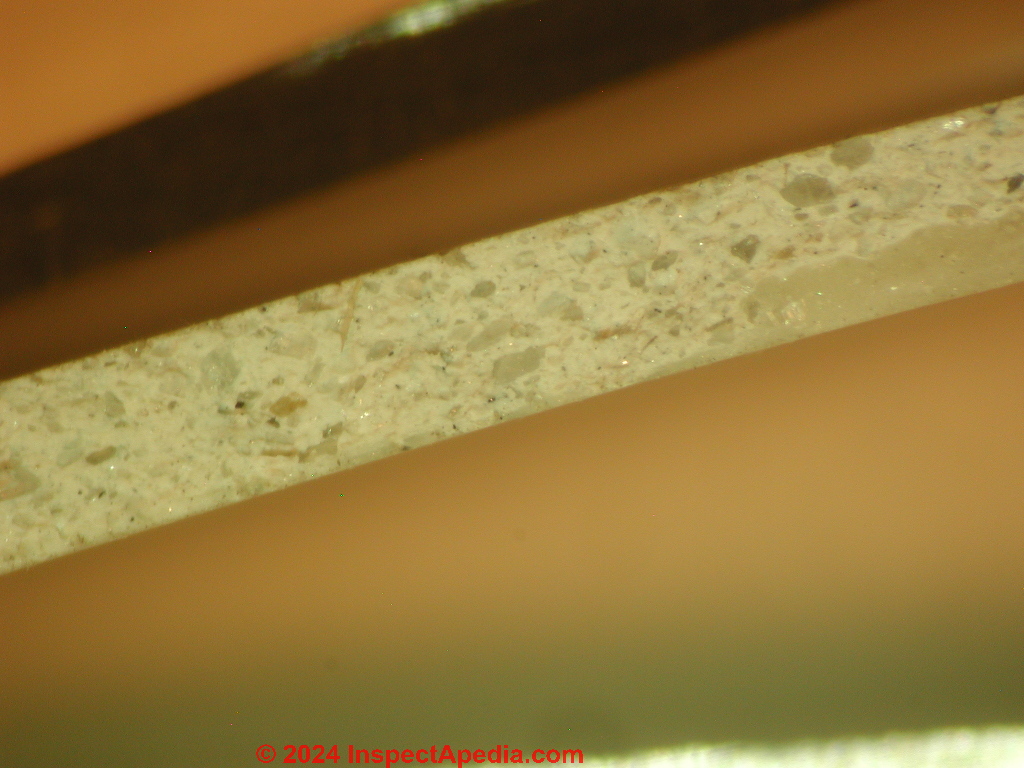
This floor tile measured at about 1.8mm in thickness.
None of these asphalt-asbestos or vinyl-asbestos floor tiles, in edge view, even with their tiny particulate inclusions look anything like the true cork floor tile whose edge we'll show below.
So actual cork floor tiles should be unmistakable - they contain actual cork material - softer woody particles (of cork).
Our photo below, included again for comparison, shows the cross-section of an actual true-cork floor tile. It's unmistakably a fibrous, soft wood-product material even without microscopic examination.
More photos of true cork flooring are
at FLOORING MATERIALS, AGE, TYPES and also
at FLOOR, RESILIENT VINYL or CORK
Bottom line: real cork flooring does not usually contain asbestos. However there were some cork products including cork bulletin boards, and possibly some cork flooring and cork wall coverings that did include asbestos for fire-resistance and possibly for strength.
Vinyl asbestos tile flooring made in a cork pattern may indeed contain asbestos.
Reader follow-up:
My new plan is to replace the tiles I've already taken up with new tile, then put a floating wood floor over the top.
According to everything I've read containment is the best way to go. Seeing as I have three other rooms with tile I think this is the easiest fix for me. What do you think?
Also, my tiles don't seem like vinyl to me. They're not plastic-y - if you know what I mean. Does vinyl get rigid?
Reply:
Depending on its formula, age and the conditions to which it has been exposed, vinyl floor tiles can be pretty hard.
Now look again very closely at the
- Softness of your floor tiles; real cork flooring is notably softer
than vinyl floor tiles: you can't really depress your thumbnail into a hard 1960's or later vinyl floor tile, but you can definitely push a thumbnail into true cork - The edge of your floor tiles and their thickness: true cork floor tiles will show individual fibrous cork particles
while vinyl floor tile edges will be more solid and homogeneous or where inclusions are shown, they resemble those in our photographs above - not woody material; see our edge photos of floor tiles above on this page.
Where floor tiles are already missing you can glue in floor tiles or use a leveling compound to make the floor smooth before installing a floating wood floor atop.
Typically the floating floor will use a rosin paper or other underlayment as well. Makes sense to me.
Yes vinyl floor tiles can get very rigid and brittle; if the tiles are thick, say 1/8" and dark inside they may be asphalt based; else probably they're vinyl. I think that the cork pattern as well as other light-colored floor tiles will generally date back to early vinyl or "plastic" floor tiles.
One of the reasons manufacturers liked vinyl is that lighter colored flooring was easier to produce when you don't start with (black) asphalt.
Reader follow-up:
Okay, that makes sense. They're not dark inside though. So they must be vinyl. So, I'm just going to cover them up.
Vinyl Flooring Products 1900 - 1986 in a Simulated Cork Pattern May Contain Asbestos
Our photo above shows another example of cork-pattern solid vinyl floor tiles from the 1960's.
Typically vinyl floor tiles, or VAT (vinyl-asbestos tile) from this era contain asbestos, and special procedures are required if the floor is to be demolished.
Similar to inlaid sheet vinyl, the color and pattern in solid cork-pattern vinyl tiles run through the full thickness of the tile, making them very durable.
Because the color and pattern extend through the tile, they do not wear away with heavy use, but choices are limited.
If your cork pattern flooring is vinyl, made before the late 1980s (in the U.S., different in other countries) then you should
see ASBESTOS FLOORING HAZARD REDUCTION
Modern solid vinyl tiles are cut from a solid block of material and come with a low-gloss finish.
One type, vinyl composition tile or VCT, is essentially the same product as solid vinyl, but with other binders and fillers. Both types require waxing and buffing, both to seal any gaps between tiles and to create an easy-to-clean surface.
- - Adapted with permission from Best Practices Guide to Residential Construction (Steve Bliss, J Wiley & Sons) .
...
Reader Comments, Questions & Answers About The Article Above
Below you will find questions and answers previously posted on this page at its page bottom reader comment box.
Reader Q&A - also see RECOMMENDED ARTICLES & FAQs
Question: are these 9x9 floor tiles cork flooring or an asbestos floor tile?
I’ve attached pictures of floor tiles in my house. (9” X 9”)
House was built in 1914, but I am not sure these tiles were original….
Any thoughts on if they are cork or Asbestos?
Thank you in advance!
Regards, - Anonymous by private email 2020/04/10
Reply:
I'd be surprised if that floor dates to 1914.
It looks like a wood product - fiberboard - or most-likely, badly deteriorated cork flooring; I can't quite see sharply-enough in the photo, but on our cork flooring identification page
you will see some detailed photos, including cross-sections and pieces of damaged cork flooring that look much like yours.
While it is not a flooring product, you might also want to compare your flooring properties with the images and properties shown at
FIBERBOARD SHEATHING IDENTIFICATION
I've posted your images here on our cork flooring identification web page to invite comment from other readers.
...
Continue reading at RESILIENT VINYL or CORK FLOOR or select a topic from the closely-related articles below, or see the complete ARTICLE INDEX.
Or see these
Recommended Articles
- ASBESTOS CORK PRODUCTS
- ASBESTOS FLOOR TILE IDENTIFICATION PHOTOS 1949-1959
- ASBESTOS FLOORING HAZARD REDUCTION
- CORK FLOORING
- FLOOR COVERINGS: 1900 - 1949
- FLOOR TILE HISTORY & INGREDIENTS
- FLOOR TYPES & DEFECTS - home
- FLOORING MATERIALS, AGE, TYPES
- MASTIC, CUTBACK ADHESIVE, FLASHING CEMENT ASBESTOS
- RESILIENT VINYL or CORK FLOOR
Suggested citation for this web page
CORK FLOORING at InspectApedia.com - online encyclopedia of building & environmental inspection, testing, diagnosis, repair, & problem prevention advice.
Or see this
INDEX to RELATED ARTICLES: ARTICLE INDEX to BUILDING FLOORING
Or use the SEARCH BOX found below to Ask a Question or Search InspectApedia
Or see
INDEX to RELATED ARTICLES: ARTICLE INDEX to BUILDING INTERIORS
Or use the SEARCH BOX found below to Ask a Question or Search InspectApedia
Ask a Question or Search InspectApedia
Try the search box just below, or if you prefer, post a question or comment in the Comments box below and we will respond promptly.
Search the InspectApedia website
Note: appearance of your Comment below may be delayed: if your comment contains an image, photograph, web link, or text that looks to the software as if it might be a web link, your posting will appear after it has been approved by a moderator. Apologies for the delay.
Only one image can be added per comment but you can post as many comments, and therefore images, as you like.
You will not receive a notification when a response to your question has been posted.
Please bookmark this page to make it easy for you to check back for our response.
IF above you see "Comment Form is loading comments..." then COMMENT BOX - countable.ca / bawkbox.com IS NOT WORKING.
In any case you are welcome to send an email directly to us at InspectApedia.com at editor@inspectApedia.com
We'll reply to you directly. Please help us help you by noting, in your email, the URL of the InspectApedia page where you wanted to comment.
Citations & References
In addition to any citations in the article above, a full list is available on request.
- In addition to citations & references found in this article, see the research citations given at the end of the related articles found at our suggested
CONTINUE READING or RECOMMENDED ARTICLES.
- Carson, Dunlop & Associates Ltd., 120 Carlton Street Suite 407, Toronto ON M5A 4K2. Tel: (416) 964-9415 1-800-268-7070 Email: info@carsondunlop.com. Alan Carson is a past president of ASHI, the American Society of Home Inspectors.
Thanks to Alan Carson and Bob Dunlop, for permission for InspectAPedia to use text excerpts from The HOME REFERENCE BOOK - the Encyclopedia of Homes and to use illustrations from The ILLUSTRATED HOME .
Carson Dunlop Associates provides extensive home inspection education and report writing material. In gratitude we provide links to tsome Carson Dunlop Associates products and services.


